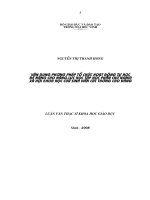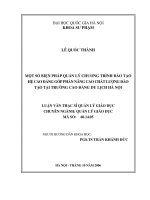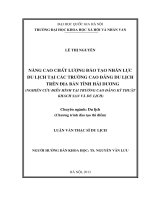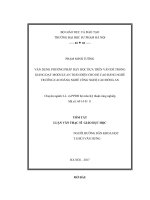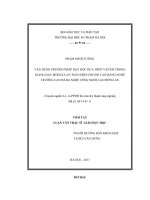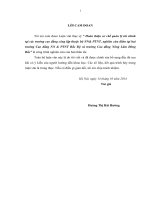BÀI GIẢNG TIẾNG ANH 1 Dành cho sinh viên chính quy hệ Đại học và Cao đẳng
Bạn đang xem bản rút gọn của tài liệu. Xem và tải ngay bản đầy đủ của tài liệu tại đây (2.22 MB, 206 trang )
HỌC VIỆN CÔNG NGHỆ BƯU CHÍNH VIỄN THÔNG
BÀI GIẢNG
TIẾNG ANH 1
(Dành cho sinh viên chính quy hệ Đại học và Cao đẳng)
NGƯỜI BIÊN SOẠN:
ThS. GVC. NGUYỄN QUỲNH GIAO
Hà Nội, 2013
PTIT
BÀI GIẢNG MÔN TIẾNG ANH 1
___________________________________________________________________________
2
LỜI NÓI ĐẦU
Trong thời kỳ hội nhập, tiếng Anh là công cụ cần thiết để giao tiếp, học tập và công tác.
Các trường đại học rất chú trọng đến môn tiếng Anh trong quá trình cung cấp nguồn nhân lực
cho xã hội. Có nhiều chuẩn để đánh giá trình độ tiếng Anh của sinh viên như IELTS, TOEFL,
TOEIC Học viện Công nghệ Bưu chính Viễn thông năm 2008 đã cam kết chuẩn đầu ra môn
tiếng Anh là 450 điểm TOEIC. Đề cương chi tiết môn tiếng Anh đã được xây dựng theo chuẩn
TOEIC, bao gồm Tiếng Anh 1 đến Tiếng Anh 6, trong đó môn Tiếng Anh 1 đến Tiếng Anh 4
gồm tiếng Anh cơ bản và một phần luyện chương trình TOEIC. Tiếng Anh 5 và Tiếng Anh 6
dành riêng cho chương trình TOEIC.
Bộ bài giảng Tiếng Anh 1 đến Tiếng Anh 6 được Bộ môn Ngoại ngữ Khoa Cơ bản 1
biên soạn theo đề cương chi tiết môn Tiếng Anh dành cho hệ chính qui của Học viện Công
nghệ Bưu chính Viễn thông.
Nội dung và bố cục của bộ bài giảng bám sát vào tài liệu New English File và Very
Easy TOEIC, Starter TOEIC, Developing Skills for the TOEIC Test, TOEIC Analyst, Tactics
for TOEIC, rất thích hợp cho người bắt đầu học tiếng Anh và tiến đến đạt chuẩn TOEIC mong
muốn. Vì vậy bộ bài giảng này cũng là tài liệu tham khảo cho những đối tượng tự học theo
chuẩn TOEIC.
Bài giảng môn Tiếng Anh 1 tương ứng với học phần Tiếng Anh 1 gồm hai phần chính:
Phần một bao gồm các nội dung kiến thức tiếng Anh cơ bản được giới thiệu trong quyển
New English File Elementary (Files 1- 4) của Clive Oxeden et.al., nhà xuất bản Oxford
University Press, tương ứng 26 tiết trên lớp.
Phần hai của tập bài giảng bắt đầu phần luyện thi TOEIC với các vấn đề từ vựng, ngữ
pháp, trong đó chú trọng luyện kỹ năng nghe và đọc được giới thiệu trong quyển Very Easy
TOEIC - Second Edition của Anne Taylor & Garrett Byrne, nhà xuất bản Compass Publisher,
tương ứng 12 tiết trên lớp.
Quyển sách cung cấp kiến thức ngữ pháp cơ bản như Present Tense, Past Tense,
Relative Pronouns, Comparisons, Conjunctions, Modifiers, Negation Quyển sách cũng cung
cấp vốn từ vựng đi kèm ở mức sơ cấp, giúp cho sinh viên luyện ngữ âm theo các chủ đề giao
tiếp thường ngày và giao tiếp trong môi trường công việc.
Tác giả đã rất cố gắng tuy nhiên do điều kiện thời gian hạn hẹp nên những thiếu sót
trong quyển bài giảng là khó tránh khỏi. Chúng tôi rất mong và xin cảm ơn sự đóng góp ý
kiến của bạn bè đồng nghiệp và các sinh viên.
Chúng tôi cũng xin chân thành cảm ơn sự tạo điều kiện giúp đỡ của Ban giám đốc Học
viện Công nghệ Bưu chính Viễn thông và sự khuyến khích động viên, những ý kiến đóng góp
quí báu của các bạn bè đồng nghiệp để chúng tôi hoàn thành được tập tài liệu này.
TÁC GIẢ
PTIT
BÀI GIẢNG MÔN TIẾNG ANH 1
___________________________________________________________________________
3
MỤC LỤC
Trang
LỜI NÓI ĐẦU 1
PART 1 - NEW ENGLISH FILE (ELEMENTARY) 2
FILE 1 ……………………………………………………………………… 2
FILE 2 32
FILE 3 60
FILE 4 93
PART 2 - VERY EASY TOEIC 120
UNIT 1 Present Tense 120
UNIT 2 Past Tense 126
UNIT 3 Gerunds / Infinitives 131
UNIT 4 Subject - Verb Agreement 137
UNIT 5 Auxiliaries 142
UNIT 6 Relative Pronouns 148
UNIT 7 Nouns / Pronouns 154
UNIT 8 Adjectives / Adverbs 160
UNIT 9 Comparisons 166
UNIT 10 Conjunctions 172
UNIT 11 Modifiers 178
UNIT 12 Negation 184
FURTHER EXERCISES 190
TÀI LIỆU THAM KHẢO 204
PTIT
BÀI GIẢNG MÔN TIẾNG ANH 1
___________________________________________________________________________
4
PART 1 - NEW ENGLISH FILE (ELEMENTARY)
FILE 1
1 A Nice to meet you
G verb be (+), pronouns: I, you, etc.
V numbers 1 – 20, days of the week
P vowel sounds, word stress
OVERVIEW:
This first lesson covers basic greetings and farewells, and the verbs be in
positive sentences, as well as numbers and the days if the week. The lesson also
introduces the New English File system of teaching the forty-four sounds of
English. Here you begin by learning six vowels sounds. You should work
systematically to improve your pronunciation.
1 SAYING HELLO
a 1.1 Listen and read. Number the pictures 1 - 4.
- Focus on the four pictures.
- Then listen to and read the four conversations and match each one to a picture.
Note:
Hello/Hi means the same, but Hi is more informal.
In the second row the words/phrases are more in formal than in the first.
b Write the word in the chart.
Note:
In English some words are said more strongly than others. E.g. in Nice to meet
you, Nice, and meet are pronounced more strongly than to and you.
PTIT
BÀI GIẢNG MÔN TIẾNG ANH 1
___________________________________________________________________________
5
Good afternoon and Good evening: There is no fixed time when afternoon
becomes evening, but Good afternoon are generally used between lunchtime and
about 5.00 pm and evening after that.
They are more formal than Hello, especially Good afternoon and Good evening.
c Listen again and repeat. Copy the rhythm.
Note:
In English some words are said more strongly than others.
e.g. Nice to meet you.
d 1.2 Role-play the dialogues with the sound effects.
- Work in pairs, focus on the picture. Act out the conversations with the sound
effects.
e Introduce yourself to five other students.
A: Hello. I‘m Antonio. What‘s your name?
B: Carla. Nice to meet you.
Additional activities: stand up; shake hands or appropriate locally gestures.
2 GRAMMAR verb be (+), pronouns
Present tense verb be (positive form)
Subject + to be + from + country / city
Subject + to be + Noun (of job)
a Complete the sentences with are, is, or am.
- Complete the gaps and check answers.
Answer:
I‘m Tom. = I am Tom.
My name‘s Janet Leigh. = My name is Janet Leigh.
You‗re in room 5. = You are in room 5.
PTIT
BÀI GIẢNG MÔN TIẾNG ANH 1
___________________________________________________________________________
6
b Grammar Bank 1A. Read the rules and do the exercises.
- Focus the exercises for 1A on p. 123. Do the exercises individually or in pairs.
Present tense verb be (positive form)
Full form Contraction
Singular
I am your teacher.
You are in room 13.
He is James.
She is Marta.
It is a school.
I‟m your teacher.
You‟re in room 13.
He‟s James.
She‟s Marta.
It‟s a school.
Plural
We are students.
You are in Class 2.
They are teachers.
We‟re students.
You‟re in Class 2.
They‟re teachers.
I: always capital
you: singular and plural
he: for a man; she: for a woman; it: for a thing
they: for people and things
In contraction: ‘ = a missing letter
Contraction used in conversations
Note:
Fluent speakers of English nearly always use contractions in conversations.
In English there is only one form of you, which is used for singular and plural and
for formal or informal situations.
3 PRONUNCIATION vowel sounds, word stress
- Focus on the cartoon. English has twenty vowel sounds.
- In File 1 you are going to learn the vowel sounds of English and in File 2 the
consonant sounds.
PTIT
BÀI GIẢNG MÔN TIẾNG ANH 1
___________________________________________________________________________
7
- Learning the sounds will help you pronounce words more clearly and
confidently.
a 1.3 Listen and repeat the words and sounds.
- The phonetic symbol in the picture represents the sounds. The phonetic
alphabet is used worldwide to help you know how words are pronounced.
Pronunciation notes:
It is important to point out that with the vowels, i.e. a, e, i, o, u, there is no one-to-
one relation between a letter and a sound, e.g. the letter I can be pronounced in
several different ways. However, there are common combinations of letters which
are usually pronounced the same way and these will be pointed out as the course
progresses.
The two dots in symbols /i: / and /u:/ mean that it‘s a long sound.
/ei/ and /ai/ are diphthongs, i.e. two sounds together (/e / and /i/, /a/ and /i/)
- Repeat these sounds a few more times.
b Write these words in the columns above. Listen and check. Repeat the words.
name is thanks my we
- Focus on the example words in the column under each sound picture. The
underlined letters are the same sound as the picture word they‘re under.
c Underline the stressed syllable in the words.
coffee sandwich internet e-mail
airport toilet hotel computer
- Even if the same or similar word exists in English language, the stress may be
on a different syllable.
d 1.5 Listen and check. Which two words are not stressed on the first syllables?
Note:
The two words not stressed on the first syllable are hotel and computer.
The majority of English words are stressed on the first syllables.
PTIT
BÀI GIẢNG MÔN TIẾNG ANH 1
___________________________________________________________________________
8
e Write the words from c in the chart.
food travel communication
coffee
f In pairs, write two more words in each column.
Answers:
food travel communication
coffee
sandwich
pizza
toilet
hotel
airport
lnternet
Computer
- Work in pairs, try to add two more English words to each column.
Suggested answers:
food travel
burger bus
coke car
apple plane
chips station
4 VOCABULARY numbers 1 – 20
a 1.6 Listen and repeat the numbers.
- Count from 1 to 20. Write all numbers from 1-20. Then do the same counting
backwards, starting from 20.
- Note that numbers 13-19 are stressed on the second syllable.
When we count in a list, 1, 2, 3, 4 etc. we usually stress numbers 13-19 on the first
syllable. However, at all other times, when we are saying them in isolation, e.g.
room 13, they are stressed on the second syllable.
PTIT
BÀI GIẢNG MÔN TIẾNG ANH 1
___________________________________________________________________________
9
b Vocabulary Bank Numbers. Do part 1.
- Go to Vocabulary Bank Numbers 1-20. These pages are vocabulary section
where you will first do the exercises as required by the Students Book, and will
then have the pages for reference to help you remember the words.
c 1.7 Listen. Where are they? Write 1-4 in the box.
- Focus on the four places (airport, sandwich bar, etc.). Listen to four short
conversations. The first time to listen, try to understand where the conversation
is taking place and write a number 1-4 in the boxes.
- Write 1-4 in the boxes, not in the spaces, e.g. after Gate number.
d Listen again. Write a number in each space.
- Listen again but this time to focus on the numbers you hear in each
conversation. Write the numbers in the gaps.
- Compare answers in pairs and then check answers.
5 SAYING GOODBYE
a 1.8 Listen and number the words.
Focus on the six different ways of saying goodbye. Repeat and note the stressed
syllables (Goodbye, Goodnight, See you, See you on Saturday, See you tomorrow).
We only say Goodnight as another way of saying goodbye at the end of the evening, or
before going to bed. We never use it as a greeting. For a greeting at night, use Hello or
Good evening (more formal).
b 1.9 Complete the days of the week with a CAPITAL letter. Listen and repeat.
- Answer the questions:
o Do you know/remember which day Saturday is?
o Which syllable is stressed?
- Focus the capital letters. In English, days of the week always start with a capital
letter.
PTIT
BÀI GIẢNG MÔN TIẾNG ANH 1
___________________________________________________________________________
10
1B I‟m not English, I‟m Scottish!
G verb be (-) and (+)
V numbers 22 – 1,000
P vowel sounds
OVERVIEW:
In this lesson, a world quiz provides the context for you to learn/ revise countries
and nationalities.
This lesson also views all present simple forms of the verb be, numbers, and six
more vowel sounds.
1 VOCABULARY countries and nationalities
a How do you say your country in English?
o How do you say your language in English?
o How do you say two countries near you in English?
b Vocabulary Bank Countries and nationalities.
- Go to Vocabulary Bank Countries and nationalities on p. 141.
- You are given five minutes to do exercise a in pairs.
c 1.10 Where‟s the stress? Listen and underline the stressed syllable. Listen and
repeat.
Japan Japanese
Germany German
China Chinese
Italy Italian
the United States American
Russia Russian
- Repeat the pairs of words.
PTIT
BÀI GIẢNG MÔN TIẾNG ANH 1
___________________________________________________________________________
11
d In pairs, do the quiz.
Tapescript 1.11:
a (In Russian) My name's Anna and I'm from Moscow.
b (In Italian) My name‘s Giovanni and I‘m from Fienze.
c (In Spanish) My name‘s Pilar and I‘m from Salamanca.
d (In Japanese) My names Takashi and I‘m from Osaka.
2 LISTENING AND SPEAKING
a 1.13 Listen and number the pictures 1-4.
- Focus on question 2. Write the languages that you think you hear.
- Focus on question 3. Write which country you think the music is from.
b Listen again and complete the dialogues.
Answer:
1 A Are you____? English
B No, I‘m ____. I‘m from Edinburgh. Scottish.
2 A Where are you from?
B We‘re from____. the United States
A Are you on holiday?
B No, we aren‘t. We‘re on business.
3 A Where‘s she from? Is she_____? Spanish
B No, she isn‘t. She‘s ____. She‘s from Buenos Aires. Argentinian
4 A Mmm, delicious. Is it ____? German
B No, it isn‘t. It‘s_____. French
c Repeat the dialogues. Copy the rhythm.
- Repeat the conversations line by line trying to copy the rhythm.
PTIT
BÀI GIẢNG MÔN TIẾNG ANH 1
___________________________________________________________________________
12
d In pairs, look at the pictures. Roleplay the dialogue.
- You have two minutes to memorize the conversations. Then in pairs roleplay
each conversation, using the pictures in 2a as a memory aid.
3 GRAMMAR verb be (-) and (+)
a Complete the chart.
Question Short answer Negative
_________You English? No, I_________. I_________English.
______ they from Spain? Yes, they_________.
______ she Portuguese? No, she_________. She________Portuguese.
_______he on business? Yes, he__________.
b Grammar bank 1b. Read the rules and do the exercises.
File 1B. Present tense verb be
(negative form)
Singular Full form Contraction form
1
st
I am not I‘m not
2
nd
You are not You aren‘t
3
rd
He/ She/ It: is not He/ She/ It: isn‘t
Plural Full form Contraction form
1
st
We are not We aren‘t
2
nd
You are not You aren‘t
3
rd
They are not They aren‘t
Grammar notes:
In conversation it is more common to use contractions than the full form.
PTIT
BÀI GIẢNG MÔN TIẾNG ANH 1
___________________________________________________________________________
13
In the negative the verb be can be contracted in 2 ways, e.g. You aren’t Italian;
You’re not Italian. Throughout New English File the first way (contracting not) has
been used, but 2 ways are accepted.
Although native speakers often use Yes, I am instead of just Yes, both ways of
answering are perfectly correct.
4 PRONUNCIATION vowel sounds
a Listen and repeat the words and sounds.
Pronunciation notes:
The /ə/ sound occurs twice in computer. The /ə/ sound occurs before or after
stressed syllables and is the most common sound in English.
The two dots in /a:/ means that this sound is long.
b Match the sentences and pictures. Write the sound words.
- Focus on the instructions and the example.
- You have to match the sentences to the pictures in a according to the
pronunciation for the underlined letter.
c 1.15 Listen and check.
- Play the tape/CD and check.
5 SPEAKING
a Ask other students.
Note: The answer to Where are you from? is usually I’m from (country) or I’m
(nationality) followed by the town when you are abroad.
b In pairs, ask about the people and things in the pictures.
Answers:
Mercedes-Benz is from Germany.
The dolls are from Russia.
The women are from Japan.
PTIT
BÀI GIẢNG MÔN TIẾNG ANH 1
___________________________________________________________________________
14
The cheese is from France.
Guinness is from Ireland.
The trainers are from the USA.
The sunglasses are from Italy.
The football fans are from Brazil.
6 VOCABULARY numbers 20-1,000
a Listen. How do you say 77 and 0 in the phone numbers?
Note: 0 is usually pronounced /əu/ in telephone numbers, although zero can be
used.
b Ask three students for their phone numbers.
c Vocabulary Bank Numbers 20 – 1,000
Write the numbers.
____________ thirty
____________ thirty-one
____________ forty
____________ forty-seven
____________ fifty
____________ fifty-nine
____________ sixty
____________ sixty-three
____________ seventy
____________ seventy-two
____________ eighty
____________ eighty-six
____________ ninety
____________ ninety-four
____________ a/ one hundred
PTIT
BÀI GIẢNG MÔN TIẾNG ANH 1
___________________________________________________________________________
15
____________ two hundred and fifty
____________ a/ one thousand
d 1.17 Listen and repeat the pairs of number. What‟s the differences?
Note: 13, 14… are stressed on the second syllable. 30, 40… are stressed on the
first syllable.
1. a. 13 b. 30
2. a. 14 b. 40
3. a. 15 b. 50
4. a. 16 b. 60
5. a. 17. b. 70
5. a. 18 b. 80
6. a. 19 b. 90
- What‘s the difference between a and b?
- 13, 14, etc are stressed on the second syllable and 30, 40, etc. are stressed on
the first syllable.
- This means that the pairs of numbers can be easily confused and this can be a
problem, even for native speakers.
e Which number do you hear? Listen and circle a or b above.
- Play the tape/CD twice and circle a or b.
f Play Bingo.
Bingo card symbol
13 70 80
60 19 15
Rule:
In pairs, complete your bingo card with six numbers from d. You must only
choose one from each pair, either 13 or 30 but not both.
Teacher call out random numbers choosing from the pairs of numbers in d.
PTIT
BÀI GIẢNG MÔN TIẾNG ANH 1
___________________________________________________________________________
16
If you have one of the numbers teacher calls out on your card, cross it off. Keep
calling until one pair has crossed off all the numbers, at which points you call out
―Bingo‖.
Check the winning pair‘s card. If it is correct you have won.
PTIT
BÀI GIẢNG MÔN TIẾNG ANH 1
___________________________________________________________________________
17
1C His name, her name
G possessive adjectives: my, your, etc.
V personal information: address, phone number, etc.
P the alphabet, /ə:/ and /au/
OVERVIEW:
The topic of where to go to study English abroad and an interview in a Dublin
language school provide the context information and practise the alphabet. The
grammar focus here is possessive adjectives and the different elements of the
lesson are brought together in the final activity, where you identify famous
actors who have unusual names.
1 LISTENING
Question: Where would you like to go to study English?
b 1.19 Mario goes to Ireland to study English. Listen to the interview and
complete the form.
Mario is a new student at a language school in Dublin (Ireland). He is being
interviewed by the school secretary.
c 1.20 Listen. Complete the receptionist‟s questions.
- Focus on the reception‘s questions
- You are given some minutes to read through them before listening.
2 PRONUNCIATlON the alphabet
a 1.21 Can you say the alphabet? Listen and repeat the letters.
- It is important to know the English alphabet because you often need to spell
names, surnames, town names, etc. (especially when you're talking on the
phone).
PTIT
BÀI GIẢNG MÔN TIẾNG ANH 1
___________________________________________________________________________
18
- Focus on the alphabet. Can you say the alphabet?
- Repeat the alphabet letter by letter after the tape/CD.
A B C D E F G H I
J K L M N O P Q
R S T U V W X Y Z
b Listen and repeat the words and sounds.
Note: The letters are in columns according to the pronunciation of each letter.
- Focus on the chart and repeat the words and sounds.
c 1.23 Write the other letters of the alphabet in the correct column. Listen and
check.
- Work in pairs, go through the alphabet, stop at the letters that are missing from
the chart and write them in the right column.
d In pairs, practice saying these abbreviations.
- Focus on the abbreviations. In English they usually say abbreviations by saying
the individual letters.
- In pairs, practice saying them.
Answers:
PC - Personal Computer OK - yes
CD - Compact Disc VIP - very important person
DVD - digital versatile disc or digital video disc
MTV - Music Television USA - the United States of America
UK - the United Kingdom BMW - Bavaria Motor Works
FBI - Federal Bureau of Investigation
3 SPEAKING
a 1.24 Listen and repeat the questions from 1c. Copy the rhythm.
What‘s your first name?
PTIT
BÀI GIẢNG MÔN TIẾNG ANH 1
___________________________________________________________________________
19
- Get the rhythm right when you speak will help you to understand and be
understood.
b Communication Interview p.111.
- Work in pairs, A and B, and sit so that you are facing each other.
- You‘re going to roleplay the interview. A is the receptionist, and B is a new
student. A is going to interview B.
4 GRAMMAR possessive adjectives
a Look at the underlined words. Which is an adjective? Which is a pronoun?
- Focus on the two sentences and the questions.
1 Where are you from?
2 What's your name?
b Complete the chart with your, my, his, her, their, our. Listen and check.
Tapescript 1.25:
I‘m Italian.
My family comes from Rome.
You‘re in level 1. This is your classroom.
He‘s the Director of Studies. His name is Michael.
She‘s your teacher. Her name is Lucy.
We‘re an international school. Our students are from different countries.
They‘re new students. Their names are Tina and Daniel.
c Grammar bank 1C. Read the rules and do the exercises.
Possessive adjectives
I my family
You your classroom
He his name
She her book
PTIT
BÀI GIẢNG MÔN TIẾNG ANH 1
___________________________________________________________________________
20
It its name
We our students
They their names
Grammar notes:
In some languages the possessive adjective agrees with the following nouns, i.e. it
can be masculine, famine, or plural depending on the gender and number of the
noun that comes after.
In English, nouns don‘t have gender, so adjectives don‘t change, and the use of
his/her simply depends on whether we are talking about something belonging to a
man or to a woman.
your is used for singular and plural.
5 PRONUNCIATION /ə:/ and /au/
a 1.26 Listen and repeat the words and sounds.
Tapescript 1.26:
bird /ə:/ owl /au/
b 1.27 Write these words in the chart. Listen and repeat the words.
her how first our now surname
- Focus on the words in the box. Note that the letters in pink are pronounced
either /ə:/ or /au/.
6 SPEAKING
Look at the photos. In pairs, ask and answer the questions.
- Focus on the flow chart. Go through the questions, making sure you are clear
that those on the right are for a woman and on the left for a man.
- Focus also on the expressions I don’t remember, I don't know, I think , and
about (= more or less, approximately).
PTIT
BÀI GIẢNG MÔN TIẾNG ANH 1
___________________________________________________________________________
21
File 1D Turn off your mobiles!
G a/ an/ plurals, this / that / these / those
V the classroom, common objects, classroom language
P vowel sounds
OVERVIEW:
In this lesson you learn or revise the vocabulary of the classroom
environment and personal possessions. This lexis is then used to practise
articles, plurals, and this/ that/ these/ those. The lesson ends with a focus on
classroom language, which helps you to understand and respond to common
classroom instructions, and to ask the teacher in English for information and
clarification.
1 VOCABULARY the classroom, common objects
a Can you see these things in your classroom? Tick or cross.
a table a light
a board a picture
a TV a video
CD player walls
a window charts
a door
- Answer the questions:
o Can you see these things?
o Where?
b 1.28 Listen and then repeat the words.
- Play the tape/CD to repeat the words. Drill any words which you find difficult.
c 1.29 What‟s in the bag? Match the worlds and pictures. Listen and check.
an address book keys
PTIT
BÀI GIẢNG MÔN TIẾNG ANH 1
___________________________________________________________________________
22
tissues an identity card
coins a lipstick
a mobile (phone) a purse
- Play the tape/CD to check your answers.
- Play again to drill pronunciation.
d Vocabulary bank common objects
Work in pairs. Match the words and pictures.
Answers:
1 a magazine 15 a diary
2 a book 16 a photo
3 cigarettes 17 a file
4 a mobile (phone) 18 a wallet
5 coins 19 stamps
6 a newspaper 20 matches
7 a purse 21 glasses
8 a comb 22 sunglasses
9 a pen 23 a lipstick
10 an identity card 24 a watch
11 tissues 25 keys
12 an address book 26 an umbrella
13 a credit card 27 a lighter
14 a pencil 28 a dictionary
2 PRONUNCIATION vowel sounds
a 1.30 Listen and the repeat the words and sounds.
You have learned 14 vowel words and sounds already.
horse
bull
up
wall door glasses
book photo look
purse sunglasses umbrella
PTIT
BÀI GIẢNG MÔN TIẾNG ANH 1
___________________________________________________________________________
23
boy
ear
tourist
coins board toilet
here we‘re there
euro Europe e-mail
Pronunciation notes
The two dots in /:/ mean that this sound is long.
b 1.31 Listen to the groups of words. Circle the word with a different vowel sound.
- Say the words aloud.
- Circle the words in each group which has a different sound from the sound
picture.
3 GRAMMAR a/ an/ plurals, this / that / these / those
Articles: a/ an, the
o Use a / an with a singular noun
o Use an with a noun beginning with a vowel (a, e, i, o, u)
o Use the when we know which
o Use the with singular and plural nouns
Nouns
Singulars Plurals
o Add -s to make plural nouns
Regular
o +s daughter daughters
parent parents
o ending in ―y‖ ‗i‘ + es
family families
secretary secretaries
o ending in ―s, x, o, ch, sh‖ + es
address addresses
six sixes
PTIT
BÀI GIẢNG MÔN TIẾNG ANH 1
___________________________________________________________________________
24
this / that / these / those
o Use this/ these for thing near you
o Use that/ those for thing far away
o this/ that = singular, these/ those = plural
Near Further away
Singular This That
Plural These Those
a Write a or an.
- Complete in pairs.
b Write the plural.
- Complete in pairs.
c Complete the questions with this that, these or those.
- Note the pronunciation of es /iz/) in watches and boxes.
Answers:
1 this 2 that 3 those 4 these
d Grammar Bank 1D. Read the rules and do the exercises.
Grammar notes:
a, an (indefinite article), the (definite article)
Plural nouns: The system in English of making regular nouns plural is very
straight forward, simply adding –s
this/ that/ these/ those: this/ that for things within reach, that, those for things out
or reach or far away
PTIT
BÀI GIẢNG MÔN TIẾNG ANH 1
___________________________________________________________________________
25
e In pairs, ask and answer. Use pictures in 1C for this/ these and point to things in
the class for that/ those.
- Work in pairs, A and B. Ask each other the questions.
- Note this, that; that and those.
4 CLASSROOM LANGUAGE
a Match the phrases and the pictures.
GIVING INSTRUCTIONS
+
-
?
Open your books (please).
(Please) don‘t write.
Can you open the door (please)?
- Focus on the box GIVING INSTRUCTIONS:
- to give [+] instructions we use the infinitive form of the verb, e g. look!
- For [-] instructions we use Don’t + the infinitive, e.g. Don’t look!
- Don't is the contracted form of Do not and is used to make the verb negative.
- These forms are the same for singular and plural.
- To make instructions more polite add ‗please‘ or use Can you + infinitive?
b 1.32 Listen. Tick (√) the ten phrases in a you hear.
- Play the tape/CD at least twice. Listen and write the number (1-10) next to the
instructions you hear.
c 1.33 Complete the sentences. Listen and check.
- Focus on the seven phrases. In pairs try to fill the gaps with one word.
- Make sure you know what the phrases mean. Repeat and use the right rhythm
d Play What’s the word?
This is a revision game to recycle classroom phrases and revise vocabulary.
PTIT

